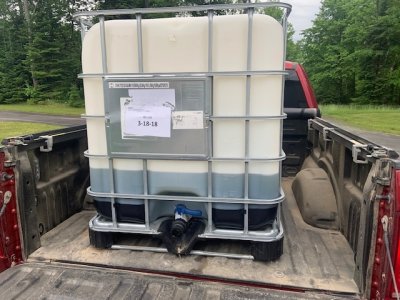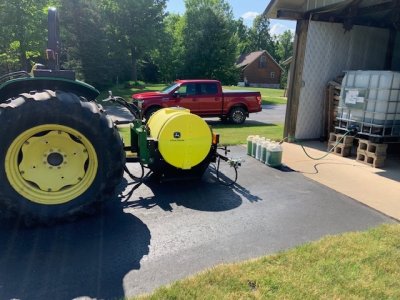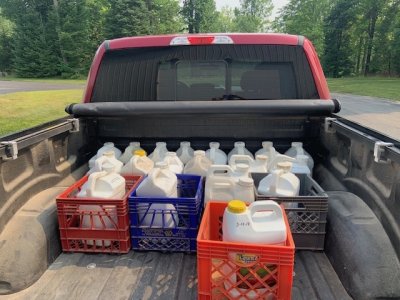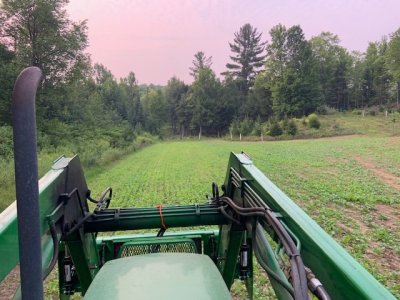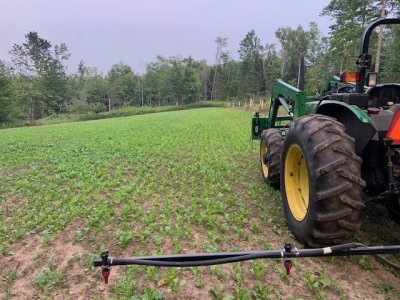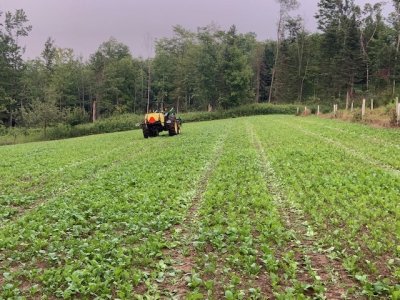Victor Van Meter
5 year old buck +
What is everyone's preference? Thanks.
VV
VV
Care to share your reasonings behind that thought?This is going to be a hot take. Liquid fertilizers have almost no practical place in food plots.
Folks who buy organic tend to demand and pay for it. IT might be covered under the cloak of "taste". Although organic farmers are not free from sin either.The big misunderstanding in fertility is that it's a matter of availability. The dirty little secret is availability isn't the problem, it's absorption.
96% of any plant material is comprised of gases. It's carbon, hydrogen, and oxygen. The other 4% is minerals and nutrients. Every acre sits on or under enough nutrients to grow for 10,000+ years with no inputs. The key to absorption is life and diversity. Life and diversity in a plot or pasture are an engine of constant production of available nutrients. Organisms large and small are constantly eating and excreting (pooping) nutrients. You could measure all your nutrients with a conventional soil test, and they could all show too low to produce a crop, yet a crop always happens. What's never accounted for is that what you see today is used today, but there is more being produced for tomorrow as well.
If you're operating in a broken system, meaning you have a fallow period caused by spraying or tillage, your crops will suffer, and require fertilization to grow, because all the critters responsible for constant production of nutrients have been killed. Plants in that kind of system will have low brix, be vulnerable to insects, fungus, and bacteria, and not taste as good to the deer. Even if foliars produced a visible change, odds are high you're gonna have nutrients out of whack and gain no actual nutrition from your tonnage.
Mark Schatzker wrote a couple great books on food and nutrition. I can't remember which is which, but they are both good. One is the Dorito Effect, and the other is The End Of Craving. In one of those, he talks about the effects of supplemental fertilization on nutrient density in farmed crops. His findings were that fertility added no nutrition. What you did gain was simply empty carbohydrates. For example, An acre of corn 100 years ago produced a given amount of nutrition at 30 bushels per acre. Today, if that acre produces 300 bushels per acre, the quantity of nutrients is the same, only the product has 90% less nutrient density. Same goes for all foods. Where science has jacked up production, nobody has figured out how to jack up nutrient density. It's tragically gone the other way, but nobody demands or pays for nutrient density.
Long story short, save your money. Get diverse, stay green, and with clover, jack up your oxygen and carbon.
Oh, not at all. They have the same problems with nutrient density that conventional growers have. In lieu of spraying, they often will do excessive tillage, and even worse, they may be using bio sludge from cities to fertilize those crops because someone paid someone else enough to label it organic.Folks who buy organic tend to demand and pay for it. IT might be covered under the cloak of "taste". Although organic farmers are not free from sin either.

Love to o my own garden. Wife cooks what she wants, most stuff would rot in the fridge."A welcome addition to the water system."
This is how mad cow started.
View attachment 80175
This is why I garden.
What are your suggestions for upping oxygen and carbon? Clover is my go-to foodplot, so I am trying to make them the best I can. Thanks.The big misunderstanding in fertility is that it's a matter of availability. The dirty little secret is availability isn't the problem, it's absorption.
96% of any plant material is comprised of gases. It's carbon, hydrogen, and oxygen. The other 4% is minerals and nutrients. Every acre sits on or under enough nutrients to grow for 10,000+ years with no inputs. The key to absorption is life and diversity. Life and diversity in a plot or pasture are an engine of constant production of available nutrients. Organisms large and small are constantly eating and excreting (pooping) nutrients. You could measure all your nutrients with a conventional soil test, and they could all show too low to produce a crop, yet a crop always happens. What's never accounted for is that what you see today is used today, but there is more being produced for tomorrow as well.
If you're operating in a broken system, meaning you have a fallow period caused by spraying or tillage, your crops will suffer, and require fertilization to grow, because all the critters responsible for constant production of nutrients have been killed. Plants in that kind of system will have low brix, be vulnerable to insects, fungus, and bacteria, and not taste as good to the deer. Even if foliars produced a visible change, odds are high you're gonna have nutrients out of whack and gain no actual nutrition from your tonnage.
Mark Schatzker wrote a couple great books on food and nutrition. I can't remember which is which, but they are both good. One is the Dorito Effect, and the other is The End Of Craving. In one of those, he talks about the effects of supplemental fertilization on nutrient density in farmed crops. His findings were that fertility added no nutrition. What you did gain was simply empty carbohydrates. For example, An acre of corn 100 years ago produced a given amount of nutrition at 30 bushels per acre. Today, if that acre produces 300 bushels per acre, the quantity of nutrients is the same, only the product has 90% less nutrient density. Same goes for all foods. Where science has jacked up production, nobody has figured out how to jack up nutrient density. It's tragically gone the other way, but nobody demands or pays for nutrient density.
Long story short, save your money. Get diverse, stay green, and with clover, jack up your oxygen and carbon.
